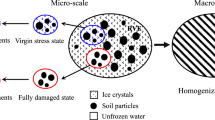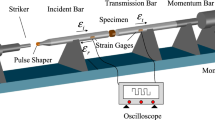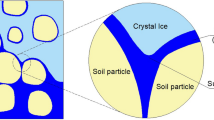Abstract
Many geotechnical engineering problems in the cold region, including cracking of pavements, damage to the foundations of structures, and fracture of pipelines are blamed due to the deformation and failure of frozen soils. In this study, cryogenic suction is used as one of the constitutive variables together with the solid-phase stress to model the joint influence of temperature and confining pressure on the constitutive behaviour of frozen soils. A nonlinear relationship is proposed to link cryogenic cohesion with cryogenic suction, to consider the strength increase due to the lowering of temperature. In the space of the solid-phase stress and cryogenic suction, loading-collapse yield surface, subloading surface, and unified hardening parameter are then integrated to produce a novel multisurface constitutive model for frozen soil. The proposed model can predict the mechanical behaviours such as softening/hardening and dilation/compression of frozen soil under various temperatures and stresses. Some special characteristics of frozen soil, including the deformation induced by ice segregation and softening related to pressure melting, can also be well explained by this model. The developed model is validated by using several triaxial compression test results of different frozen soils in the literature.















Similar content being viewed by others
References
Alonso EE, Gens A, Josa A (1990) A constitutive model for partially saturated soils. Geotechnique 40(3):405–430. https://doi.org/10.1680/geot.1990.40.3.405
Andersen GR, Swan CW, Ladd CC, Germaine JT (1995) Small-strain behavior of frozen sand in triaxial compression. Can Geotech J 32(3):428–451
Arenson LU, Springman SM (2005) Mathematical descriptions for the behaviour of ice-rich frozen soils at temperatures close to 0 C. Can Geotech J 42(2):431–442
Asaoka A, Nakano M, Noda T, Kaneda K (2000) Delayed compression/consolidation of natural clay due to degradation of soil structure. Soils Found 40(3):75–85. https://doi.org/10.3208/sandf.40.3_75
Black PB (1995) Application of the Clapeyron equation to water and ice in porous media. CRREL, US Army Corps of Engineers
Bragg RA, Andersland OB (1981) Strain rate, temperature, and sample size effects on compression and tensile properties of frozen soil. Eng Geol 18:35–46. https://doi.org/10.1016/0013-7952(81)90044-2
Chamberlain E, Groves C, Perham R (1972) The mechanical behaviour of frozen earth materials under high pressure triaxial test conditions. Geotechnique 22(3):469–483. https://doi.org/10.1680/geot.1972.22.3.469
Chang D, Lai YM, Yu F (2019) An elastoplastic constitutive model for frozen saline coarse sandy soil undergoing particle breakage. Acta Geotech 14:1757–1783
Culley RW (1971) Effect of freeze-thaw cycling on stress-strain characteristics and volume change of a till subjected to repetitive loading. Can Geotech J 8(3):359–371. https://doi.org/10.1139/t71-038
Coussy O (2005) Poromechanics of freezing materials. J Mech Phys Solids 53(8):1689–1718. https://doi.org/10.1016/j.jmps.2005.04.001
Dagesse DF (2010) Freezing-induced bulk soil volume changes. Can J Soil Sci 90:389–401
Drouin M, Michel B (1971) Les poussées d’origine thermique exercées parles couverts de glace sur les structures hydrauliques. Faculté des sciences, Université Laval, Quebec City, Que
Ghoreishian Amiri SA, Grimstad G, Kadivar M, Nordal S (2016) Constitutive model for rate-independent behavior of saturated frozen soils. Can Geotech J 53(10):1646–1657. https://doi.org/10.1139/cgj-2015-0467
Hamilton AB (1966) Freezing shrinkage in compacted clays. Can Geotech J 3(1):1–17
Han L, Ye GL, Li YH, Xia XH, Wang JH (2015) In situ monitoring of frost heave pressure during cross passage construction using ground-freezing method. Can Geotech J 53(3):530–539. https://doi.org/10.1139/cgj-2014-0486
Hashiguchi K (1989) Subloading surface model in unconventional plasticity. Int J Solids Struct 25(8):917–945
He P, Zhu YL, Cheng GD (2000) Constitutive models of frozen soil. Can Geotech J 37(4):811–816. https://doi.org/10.1139/t00-014
He RX, Jin HJ (2010) Permafrost and cold-region environmental problems of the oil product pipeline from Golmud to Lhasa on the Qinghai-Tibet Plateau and their mitigation. Cold Reg Sci Technol 64(3):279–288
Henry KS (2000) A review of the thermodynamics of frost heave. CRREL, US Army Corps of Engineers
Hoque MA, Pollard WH (2009) Pollard Arctic coastal retreat through block failure. Can Geotech J 46:1103–1115
Hoekstra P (1966) Moisture movement in soils under temperature gradients with the cold-side temperature below freezing. Water Resour Res 2(2):241–250
Horpibulsuk S, Liu MD, Liyanapathirana DS, Suebsuk J (2010) Behaviour of cemented clay simulated via the theoretical framework of the Structured Cam Clay model. Comput Geotech 37:1–9. https://doi.org/10.1016/j.compgeo.2009.06.007
Konrad JM, Morgenstern NR (1981) The segregation potential of a freezing soil. Can Geotech J 18(4):482–491
Konrad JM, Duquennoi C (1993) A model for water transport and ice lensing in freezing soils. Water Resour Res 29(9):3109–3124. https://doi.org/10.1029/93WR00773
Koopmans RWR, Miller RD (1966) Soil freezing and soil water characteristic curves. Soil Sci Soc Am J 30:680–685. https://doi.org/10.2136/sssaj1966.03615995003000060011x
Kurylyk BL, Watanabe K (2013) The mathematical representation of freezing and thawing processes in variably-saturated, non-deformable soils. Adv Water Resour 60:160–177. https://doi.org/10.1016/j.advwatres.2013.07.016
Ladanyi B (1972) An engineering theory of creep of frozen soils. Can Geotech J 9(1):63–80
Lai YM, Liu SY, Wu ZW, Liu SY, Den XJ (2002) Approximate analysis for the coupled problem of temperature fields in cold region circular tunnels. Cold Reg Sci Technol 13(4):43–49
Lai Y, Jin L, Chang X (2009) Yield criterion and elasto-plastic damage constitutive model for frozen sandy soil. Int J Plast 25(6):1177–1205. https://doi.org/10.1016/j.ijplas.2008.06.010
Lai Y, Yang Y, Chang X, Li S (2010) Strength criterion and elastoplastic constitutive model of frozen silt in generalized plastic mechanics. Int J Plast 26(10):1461–1484. https://doi.org/10.1016/j.ijplas.2010.01.007
Lai Y, Xu X, Yu W, Qi J (2014) An experimental investigation of the mechanical behavior and a hyperplastic constitutive model of frozen loess. Int J Eng Sci 84:29–53. https://doi.org/10.1016/j.ijengsci.2014.06.011
Lai Y, Liao M, Hu K (2016) A constitutive model of frozen saline sandy soil based on energy dissipation theory. Int J Plast 78:84–113. https://doi.org/10.1016/j.ijplas.2015.10.008
Liu MD, Carter JP (2000) Modelling the destructuring of soils during virgin compression. Géotechnique 50:479–483. https://doi.org/10.1680/geot.2000.50.4.479
Liu ZY, Liu JK, Li X, Fang JH (2019) Experimental study on the volume and strength change of an unsaturated silty clay upon freezing. Cold Reg Sci Technol 157:1–12. https://doi.org/10.1016/j.coldregions.2018.09.008
Mageau DW, Morgenstern NR (1980) Observations on moisture migration in frozen soils. Can Geotech J 17(1):54–60
Miller RD (1972) Freezing and heaving of saturated and unsaturated soils. Highw Res Rec 393:1–11
Morgenstern NR, Roggensack WD, Weaver JS (1980) The behaviour of friction piles in ice and ice-rich soils. Can Geotech J 17(3):405–415. https://doi.org/10.1139/t80-047
Nguyen LD, Fatahi B, Khabbaz H (2014) A constitutive model for cemented clays capturing cementation degradation. Int J Plast 56:1–18. https://doi.org/10.1016/j.ijplas.2014.01.007
Nishimura S, Gens A, Olivella S, Jardine RJ (2009) THM-coupled finite element analysis of frozen soil: formulation and application. Géotechnique 59:159–171. https://doi.org/10.1680/geot.2009.59.3.159
Nixon JF (1978) Foundation design approaches in permafrost areas. Can Geotech J 15(1):96–112
Nixon JF (1991) Discrete ice lens theory for frost heave in soils. Can Geotech J 28(6):843–859
Nova R, Castellanza R, Tamagnini C (2003) A constitutive model for bonded geomaterials subject to mechanical and/or chemical degradation. Int J Numer Anal Meth Geomech 27:705–732. https://doi.org/10.1002/nag.294
Parameswaran VR (1980) Deformation behaviour and strength of frozen sand. Can Geotech J 17(1):74–88. https://doi.org/10.1139/t80-007
Rix HH (1969) Vertical movements and crack-width changes on highway pavement surfaces. Can Geotech J 6:253–270
Roscoe KH, Burland JB (1968) On the generalized stress-strain behaviour of wet clay. In: Heyman J, Leckie FA (eds) Engineering plasticity. Cambridge University Press, Cambridge, pp 535–609
Rotta Loria AF, Frigo B, Chiaia B (2017) A non-linear constitutive model for describing the mechanical behaviour of frozen ground and permafrost. Cold Reg Sci Technol 133:63–69. https://doi.org/10.1016/j.coldregions.2016.10.010
Schofield A, Wroth P (1968) Critical state soil mechanics. McGraw-Hill, New York
Simonsen E, Isacsson U (1999) Thaw weakening of pavement structures in cold regions. Cold Reg Sci Technol 29(2):135–151
Sun DA, Matsuoka H, Yao YP (2000) An elastoplastic model for unsaturated soil in three-dimensional stresses. Soils Found 40(3):17–28
Sun K, Tang L, Zhou A, Ling X (2020) An elastoplastic damage constitutive model for frozen soil based on the super/subloading yield surfaces. Comput Geotech 128:103842. https://doi.org/10.1016/j.compgeo.2020.103842
Thomas HR, Cleall P, Li Y-C, Harris C, Kern-Luetschg M (2009) Modelling of cryogenic processes in permafrost and seasonally frozen soils. Géotechnique 59(3):173–184
Ting J, Martin R, Ladd C (1983) Mechanisms of strength for frozen sand. J Geotechn Eng 109(10):1286–1302. https://doi.org/10.1061/(ASCE)0733-9410(1983)109:10(1286)
Vanneste M, Mienert J, Bünz S (2006) The Hinlopen Slide: a giant, submarine slope failure on the northern Svalbard margin, Arctic Ocean. Earth Planet Sci Lett 245(1–2):373–388
Watanabe K, Wake T (2009) Measurement of unfrozen water content and relative permittivity of frozen unsaturated soil using NMR and TDR. Cold Reg Sci Technol 59:34–41. https://doi.org/10.1016/j.coldregions.2009.05.011
Xu G (2014) Hypoplastic constitutive models for frozen soil. Ph.D. dissertation, University of Natural Resources and Life Sciences, Vienna, Austria
Xu G, Wu W, Qi J (2016) An extended hypoplastic constitutive model for frozen sand. Soils Found 56(4):704–711. https://doi.org/10.1016/j.sandf.2016.07.010
Xu XT, Li QL, Xu GF (2020) Investigation on the behavior of frozen silty clay subjected to monotonic and cyclic triaxial loading. Acta Geotech 15:1289–1302
Yamamoto Y, Springman SM (2014) Axial compression stress path tests on artificial frozen soil samples in a triaxial device at temperatures just below 0 C. Can Geotech J 51(10):1178–1195
Yang Y, Gao F, Lai Y, Cheng H (2016) Experimental and theoretical investigations on the mechanical behavior of frozen silt. Cold Reg Sci Technol 130:59–65. https://doi.org/10.1016/j.coldregions.2016.07.008
Yang Y, Lai Y, Dong Y, Li S (2010) The strength criterion and elastoplastic constitutive model of frozen soil under high confining pressures. Cold Reg Sci Technol 60(2):154–160. https://doi.org/10.1016/j.coldregions.2009.09.001
Yao YP, Sun DA, Matsuoka H (2008) A unified constitutive model for both clay and sand with hardening parameter independent on stress path. Comput Geotech 35(2):210–222
Yao YP, Hou W, Zhou AN (2009) UH model: three-dimensional unified hardening model for overconsolidated clays. Geotechnique 59(5):451–469. https://doi.org/10.1680/geot.2007.00029
Yao YP, Zhou AN (2013) Non-isothermal unified hardening model: a thermo-elasto-plastic model for clays. Géotechnique 63(15):1328–1345
Zhang Y, Michalowski RL (2015) Thermal-hydro-mechanical analysis of frost heave and thaw settlement. J Geotech Geoenviron Eng 141:04015027. https://doi.org/10.1061/(ASCE)GT.1943-5606.0001305
Zhang D, Liu E, Liu X, Zhang G, Song B (2017) A new strength criterion for frozen soils considering the influence of temperature and coarse-grained contents. Cold Reg Sci Technol 143:1–12. https://doi.org/10.1016/j.coldregions.2017.08.006
Zhang SJ, Lai YM, Zhang XF, Pu YB, Yu WB (2004) Study on the damage propagation of surrounding rock from a cold-region tunnel under freeze–thaw cycle condition. Tunn Undergr Space Technol 19(3):295–302
Zhou A, Sheng D (2009) Yield stress, volume change, and shear strength behaviour of unsaturated soils: validation of the SFG model. Can Geotech J 46(9):1034–1045
Zhou AN, Sheng DC (2015) An advanced hydro-mechanical constitutive model for unsaturated soils with different initial densities. Comput Geotech 63:46–66
Acknowledgements
Financial support from the National Natural Science Foundation of China (52078021) and Chinese Scholarship Council (201906125027) is acknowledged.
Author information
Authors and Affiliations
Corresponding author
Additional information
Publisher's Note
Springer Nature remains neutral with regard to jurisdictional claims in published maps and institutional affiliations.
Appendices
Appendix 1: Derivation of elastoplastic constitutive flexibility matrix C
The partial differentials of the yield function to the stress in Eqs. (30), (31) and (32) are presented are as follows:
where \(X_{1} = \left( {\lambda_{0} - \lambda } \right)/\left( {\lambda - \kappa } \right)\).
The movement of the yield surface is controlled by the increment of \(\varepsilon_{v}^{mp}\) and \(\varepsilon_{v}^{sp}\), i.e. \(p_{x} = F\left( {\varepsilon_{v}^{mp} , \varepsilon_{v}^{sp} } \right)\). Therefore, by using the chain rule, the partial differential of \(p_{x}\) can be obtained as:
where
Appendix 2: The elements in the matrix \({\varvec{C}}\)
The elements in the matrix are as follows:
where
Rights and permissions
About this article
Cite this article
Sun, K., Zhou, A. A multisurface elastoplastic model for frozen soil. Acta Geotech. 16, 3401–3424 (2021). https://doi.org/10.1007/s11440-021-01391-7
Received:
Accepted:
Published:
Issue Date:
DOI: https://doi.org/10.1007/s11440-021-01391-7




